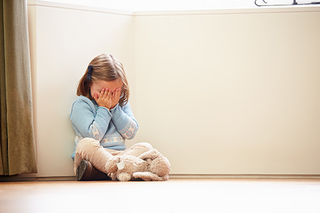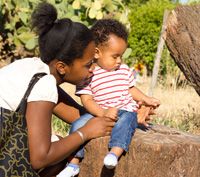Parent Qho Continue to Use Physical Punishment After Age 10 Tend to Have Children Who
"I'm sick and tired of violence… I'm tired of war and conflict in the world. I'm tired of shooting. I'm tired of hatred. I'm tired of selfishness. I'm tired of evil. I'm not going to use violence no matter who says it!" —Martin Luther King, Jr.
"Parents… have come to realize that children can be well behaved, cooperative, and polite without ever having been punished physically." —Benjamin Spock
Physical Punishment—and Violence
For some time, we have been exploring the three pillars of human development: affects (feelings), language, and cognition. We have suggested that there is a revolution in our understanding of human development and that these advances have tremendous potential for enhancing development.

Source: Adair Design
In the July 2015 Newsletter, we noted that affect, language, and cognition are all important on their own, yet they are intimately connected and overlapping. Therefore, we are utilizing this overarching context of the integration of feelings, language, and cognition to explore four major issues: the verbalization of affects, physical punishment, education, and religion.
In last month's Newsletter, we examined "Verbalization of Affects: Putting Words to Feelings." This month, we will discuss the crucial issue of "Physical Punishment—and Violence." We will summarize the problems associated with physical punishment, explore why physical punishment is so damaging, and discuss the alternatives which result from our integration of feelings, language, and cognition.
Physical punishment elicits precisely the negative affects one does not want in parent-child relationships and socializing children: distress, anger, fear, shame, and disgust. Socializing and discipline can be accomplished through the positive affects of interest and enjoyment and the early use of language and cognition with infants and young children.
Physical Punishment: A Serious Public Health Problem
Physical punishment is a serious public health problem throughout the world, and it profoundly affects the mental health of children and the societies in which we live.
In the United States, studies show that approximately 65 percent of adults approve of physical punishment, and about 50 percent of families use physical punishment to discipline children. Yet, research documents that physical punishment is associated with increases in delinquency, antisocial behavior, and aggression in children, and decreases in the quality of the parent-child relationship, children's mental health, and children's capacity to internalize socially acceptable behavior. Adults who have been subjected to physical punishment as children are more likely to abuse their own child or spouse and to manifest criminal behavior (Gershoff, 2008).
Spanking is a euphemism for hitting. One is not permitted to hit one's spouse or a stranger; such actions are defined as the crime of assault. Nor should one be permitted to hit a small and vulnerable child.
Studies show that children who are hit identify with the aggressor and are more likely to become hitters themselves: that is, bullies and future abusers of their own children and partners. They tend to learn to use violent behavior as a way to deal with stress and interpersonal disputes.
Defining Physical Punishment
Physical punishment has been defined as "the use of physical force with the intention of causing a child to experience bodily pain or discomfort so as to correct or punish the child's behavior" (Gershoff, 2008, p. 9). This includes: spanking, hitting, pinching, squeezing, paddling, whipping, "whupping," swatting, smacking, slapping, washing a child's mouth with soap, making a child kneel on painful objects, and forcing a child to stand or sit in painful positions for long periods of time.
Physical abuse has been characterized by "the infliction of physical injury as a result of punching, beating, kicking, biting, burning, shaking, or otherwise harming a child" (Nat'l Clearinghouse on Child Abuse and Neglect, 2000, as cited in Gershoff, 2002, p. 540). Behaviors that cause pain but not physical injury are considered physical punishment, whereas behaviors that risk physical injury are termed physical abuse.
However, recent research questions the traditional physical punishment-abuse dichotomy: Most physical abuse occurs during episodes of physical punishment. Physical abuse often follows when physical punishment is the intent, form, and effect of discipline. Both physical punishment and physical abuse must be addressed and stopped. Alternatives exist which are more effective in enhancing the healthy development of children.
The Research Data: The Problem With Physical Punishment
The data documenting the associations between physical punishment and psychopathology and sociopathy are compelling. They can no longer be overlooked. Pioneering research has been conducted in this area over the past decade by Gershoff, Bitensky, Straus, Holden, Durrant, and others.
Gershoff (2008, 2002) examined hundreds of studies and presented the results of the meta-analyses of the association between parental physical punishment and child and adult outcomes. She found that in childhood, physical punishment was positively associated with aggression, delinquent and antisocial behavior, and being the victim of physical abuse; it was negatively associated with the quality of the parent-child relationship, mental health, and more internalization (child's internalizing of socially acceptable behavior); and associations with immediate compliance were mixed.
When measured in adulthood, physical punishment was positively associated with aggression, criminal and antisocial behavior, and adult abuse of one's own child or spouse; physical punishment was negatively associated with mental health.
Gershoff (2008, 2002) also summarized the various demographic and risk factors, which are more likely to be associated with the use of physical punishment: being single, separated, or divorced; excessive stress from negative life events; maternal depression; lower income, education, and job status; living in the southern part of the United States; and holding conservative religious beliefs and affiliation.
Bitensky (2006) presented a detailed summary of the international findings regarding physical punishment. She also described the various efforts made by the United Nations to prevent physical punishment. The issues are detailed below.
Durrant and Ensom (2012) have provided an eloquent historical review and summary of recent research. In addition, they outlined the steps necessary to continue the progress toward eliminating physical punishment. More recently, Straus et al. have done a remarkable job summarizing the research on associations between physical punishment and various psychopathology and sociopathy (2014). They found 15 major trends associated with physical punishment:
1. Increased antisocial behavior and delinquency as a child and as a young adult
2. Greater approval of other forms of violence, such as the belief that torture is sometimes justified to obtain information critical for national defense, or that there are occasions when it is justified to slap a wife or husband
3. Greater impulsiveness and less self-control
4. Poorer parent-child relationships
5. Riskier sexual behavior as a teenager
6. Greater juvenile delinquency
7. More crime perpetrated as an adult
8. Poorer national average mental ability
9. Lower probability of graduating from college
10. Higher probability of depression
11. More violence against marital, cohabitating, and dating partners
12. More violence against non-family members
13. More physical abuse of children
14. More drug abuse
15. More sexual coercion and physically-forced sex
This growing body of research strongly suggests that a variety of poor outcomes are associated with physical punishment. There are more than 40 countries that have prohibited physical punishment in all settings, including the home.
Are there studies of outcomes in countries which have prohibited physical punishment? One such investigation was conducted in Finland by Karin Österman et al. and published in 2014. This was 28 years after the complete ban on physical punishment of children in Finland.
Two findings stand out from this study of over 4,500 people. First, greater amounts of physical punishment were associated with greater alcohol abuse, depression, mental health problems, divorce, and suicide attempts. Second, and perhaps most strikingly, the decline in physical punishment was associated with a similar decline in the number of murdered children. Additional studies of countries banning physical punishment have shown a significant decrease in adult approval of physical punishment.
The International Community and Physical Punishment
Internationally, there is increasing consensus that the physical punishment of children violates international human rights laws.

Source: Lynnae Holmes/Adair Design
Several United Nations treaties address violence towards children, with the United Nations Convention on the Rights of the Child (CRC or the Children's Convention, adopted in 1989) presenting one of the most comprehensive cases regarding the prohibition of physical punishment of children.
We know that even infants experience physical pain. Various biochemical markers and their facial expressions indicate this. In an attempt to stop what is called legalized violence toward children, and in response to the emerging data, the United Nations proposed a ban on the physical punishment of children. This is contained in the CRC.
The CRC came into force in 1990, after it was ratified by the required number of nations. Currently, 194 countries are a party to it, including every member of the United Nations, except Somalia, South Sudan, and the United States. The CRC states that all parties must "take all appropriate legislative, administrative, social and educational measures to protect the child from all forms of physical or mental violence."
In General Comment 8 in 2006, the Committee on the Rights of the Child stated there was an "obligation of all state parties to move quickly to prohibit and eliminate all corporal punishment and all other cruel or degrading forms of punishment of children."
Such work has led to over 100 countries prohibiting physical punishment in schools, and 44 countries banning physical punishment in all settings, including the home. Of these 44 countries, 28 are in Europe, seven in Africa, and several in South and Central America. These include Sweden, Finland, Spain, Austria, Germany, Israel, Kenya, Tunisia, Venezuela, Argentina, and Brazil. The laws and consequences tend to be more educative (about development) than punitive.
The United States has not banned physical punishment, but the approval of physical punishment in the United States has declined gradually and steadily over the past 40 years. The United States has signed, but not ratified, the CRC. Remarkably, 19 states still permit physical punishment in schools. These are Alabama, Arizona, Arkansas, Colorado, Florida, Georgia, Idaho, Indiana, Kansas, Kentucky, Louisiana, Mississippi, Missouri, North Carolina, Oklahoma, South Carolina, Tennessee, Texas, and Wyoming.
We know now physical punishment does not work; it makes things worse, and there are better alternatives. Why is physical punishment so damaging? Affect theory helps us understand this.
Physical punishment elicits intense and toxic negative affects: fear, distress, anger, shame, and disgust. In other words, physical punishment causes precisely the feelings one does not want, the negative affects, rather than the feelings one does want—the positive affects of interest and enjoyment.
Alternatives to Physical Punishment
Discipline means teaching.
Discipline—whether physical punishment or alternatives—is used to help socialize children's behaviors and enhance their interpersonal skills. Discipline means teaching.

Source: Lynnae Holmes/Adair Design
What are the alternatives to physical punishment?
For this, we turn to affects, language, and cognition. Many organizations have wonderful Position Statements discussing the alternatives—e.g., the American Academy of Pediatrics and the American Psychoanalytic Association.
For example, the American Academy of Pediatrics concludes: "Corporal punishment is of limited effectiveness and has potentially deleterious side effects. The American Academy of Pediatrics recommends that parents be encouraged and assisted in the development of methods other than spanking for managing undesired behavior" (Am. Acad. Ped., 1998, p. 723).
There are two core alternatives that stand out, and these are driven by feelings-language-cognition connections. The first involves the idea of using words instead of actions, and the second focuses on the behaviors of the parents/caregivers. I will present them as one might in talking with parents:
1. Use words to explain your feeling. Use words to label your child's feelings.
The influence of language begins long before the child can talk (Vivona, 2013); in other words (ha!), listen to and talk with your child.
2. Set a good example.
These identification processes—preverbal and verbal—are among the most important factors in the formation of character structure and psychological health (Gedo, 2005).
Act and talk as you would want your child to act and talk. Your child strives to be like you.
The rationale for these two interventions has been described previously and involves the affect-language-cognition connection. There are many effective interventions on individual, group, and community levels that address the issue of violence toward children (e.g., Zeanah, 2000). The foundation of all of these is understanding the feelings of the child and parent/caregiver and connecting them with language.
The American Psychoanalytic Association's Position Statement (Revised 2013) is useful in expanding the discussion on alternatives to physical punishment. It reads in part:
1. Talking and Listening: One of the most useful ways to achieve healthy child development is to promote using words instead of actions. Increasing the child's capacity to put words to feelings and actions results in increased tension regulation (awareness of feelings and ability to tolerate them without having to act), self-awareness, and thoughtful decision-making. This process is accomplished by:
- Talking and using words instead of actions — Talk rather than hit. Talk with the child about what behaviors are acceptable or not, what is safe or dangerous, and why.
- Listening to the child — Find out why he/she did or did not do something.
- Explaining your reasons — This will enhance the child's decision-making capacities.
2. Discipline as Learning: The word "discipline" comes from the Latin word for "teaching" or "learning." Children's behaviors have meaning, and behaviors are directly connected to inner feelings. Thus, discipline is a process that focuses on feelings and the behaviors that result from these feelings.
Having realistic expectations of the level of self-control, patience, and judgment your child has at a given developmental stage greatly enhances effective discipline.
3. Label Feelings: Help the child label his or her feelings with words as early as possible. Feelings such as interest, enjoyment, surprise, distress, anger, fear, shame, and disgust should be labeled with words. This facilitates tension regulation and aids the transition to more mature ways of handling emotion.
4. Positive Reinforcement: Rewards and praise will enhance the child's self-esteem when appropriate standards are met. Positive reinforcement is more effective in obtaining long-term behavioral compliance than punishments that evoke feelings of fear and shame.
5. Teach by Example: Set a good example for the child. The child wants to be like the parents. Children identify with their parents, and they will put feelings and actions into words when they see their parents doing this. Who the parents are, and how they behave, will have a profound impact on the development of their children. A child will follow the parent's lead.
6. Parents Need to Care for Themselves: An exhausted, overburdened, or stressed parent is less patient and less able to strategize effective, non-physical approaches to discipline. Alcohol use also dramatically decreases parental frustration tolerance and increases impulsivity and resorting to violence.
Verbal Abuse
In addition to physical punishment, verbal abuse also has a destructive impact on children. In fact, much of what we discussed in the sections on feelings and language dealt with this.
Remember the old ditty? "Sticks and stones will break my bones, but words will never hurt me…" How untrue is this! And how poignant that such a ditty exists as a way to fend off the pain of verbal abuse, bullying, taunting, and the like.
Of course, words can hurt. They can massively disrupt one's sense of self, self-confidence, self-cohesion—child or adult. This problem of verbal trauma involves the entire field of psychoanalysis and psychotherapy. The differences between verbal support and verbal abuse can be understood when one asks if the words are eliciting positive or negative affects.
Physical Punishment and Public Health
To summarize, there are three crucial areas of intervention on the public health level to aid in preventing the physical punishment of children:
1. Education about the psychological problems caused by physical punishment and alternative approaches to discipline. Educational efforts should be directed towards parents, caregivers, educators, clergy, legislators, and the general public.
2. Legislation to protect all children from physical punishment.
3. Research about alternative methods of disciplining and managing children and about the best ways to communicate these methods to parents, educators, and caregivers.
So, to sum up: This month, we explored "Physical Punishment—and Violence" in the context of our three aspects of human development—affects (feelings), language, and cognition. Next month, we will explore education.
Dr. Holinger's Recommended Children's Book of the Month
The Rainbabies
Author: Laura Krauss Melmed
Illustrator: Jim LaMarche
Op-Ed of the Month
Psychiatry's Identity Crisis
By Richard A Friedman, M.D.
New York Times, Sunday, July 19, 2015
Dr. Friedman presents a thoughtful discussion of the dilemma regarding the "talking cures" (various forms of psychotherapy, psychoanalysis, and so on) and medications.
moralesseentrusels.blogspot.com
Source: https://www.psychologytoday.com/us/blog/great-kids-great-parents/201508/physical-punishment-and-violence
0 Response to "Parent Qho Continue to Use Physical Punishment After Age 10 Tend to Have Children Who"
Post a Comment